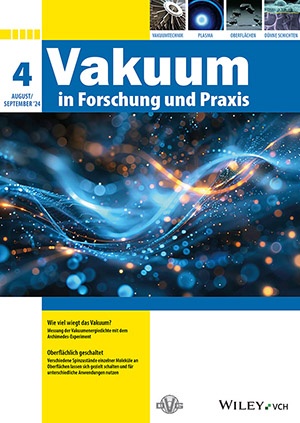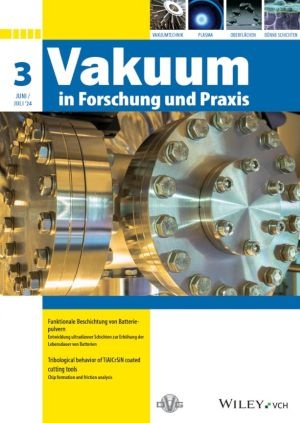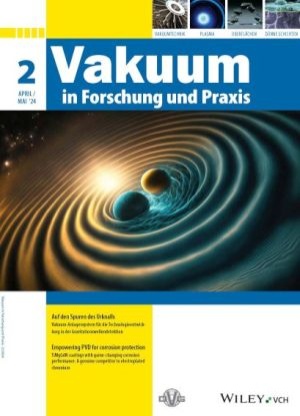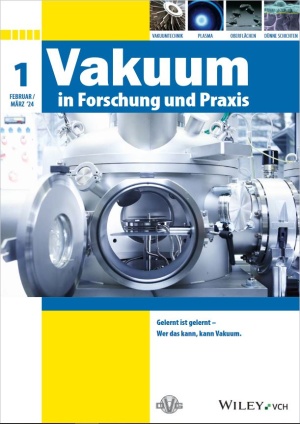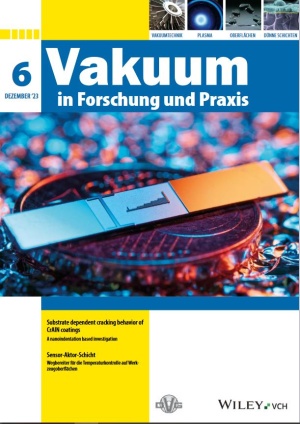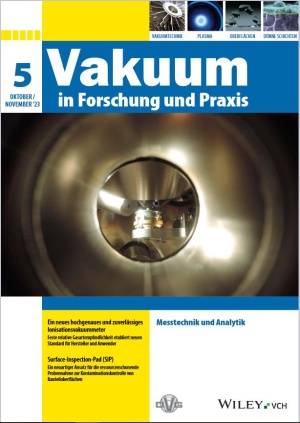Die RPS400-Anlage für Rolle-zu-Rolle-Plasmabehandlungen flexibler Materialien.
(Bild: Roplass s.r.o. – a spin-off of Masaryk University in Brno, Czech Republic)

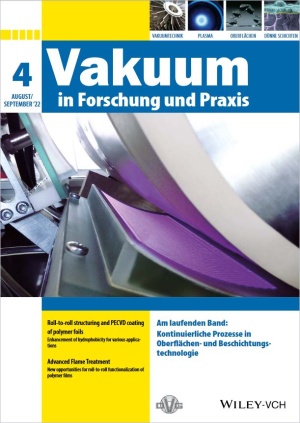
Die RPS400-Anlage für Rolle-zu-Rolle-Plasmabehandlungen flexibler Materialien.
(Bild: Roplass s.r.o. – a spin-off of Masaryk University in Brno, Czech Republic)
Free Access
Full Access
Tomáš Homola, Jakub Kelar, Mirko Černák, Dušan Kováčik
The aim of the current paper is to introduce technology for the generation of high-power density surface plasma by a diffuse coplanar surface barrier discharge (DCSBD) plasma unit. The diffuse and uniform plasma generated in low-cost gases such as open air enables easy integration into novel or existing roll-to-roll (R2R) lines. We briefly discuss the history of the development of dielectric barrier discharges (DBDs) toward the most advanced plasma sources based on the coplanar arrangement of electrodes. Moreover, we present and discuss the advantages and disadvantages of the effect of volume and coplanar DBD treatments performed in R2R mode on the surface of polyamide. The paper also discusses the potential of R2R plasma treatments for next-generation applications of novel flexible and printed electronics.
Open Access
Steffen Günther, Elisa Kutschke, Andreas Bork
Roll-to-roll processes are well-known for its high throughput, low cost, high quality and high yield potentials. They are commonly used if flexible substrates like paper, metal foils or polymer films have to be processed. Focusing on the latter, it is common to tailor their surface properties to certain needs. Therefore, technologies like chemical (CVD) or physical vapor deposition (PVD) processes are used. Such processing is very often combined with stress like thermal load or mechanical strain. This stress is limiting the productivity due to physical limitations of the material itself, like low thermal stability or very small elastic modulus and especially in its combination. The treatment of such polymers by electron beam at atmospheric pressure may alter the mentioned properties. Respective investigations of polyester, polyethylene and different kinds of bio-based polymers with respect to elastic modulus, puncture resistance and thermal stability will be shown.
Open Access
In the innovation field “Functional Surfaces and Materials” at the Fraunhofer IGB, research is being carried out to tailor the surface properties of PU foils and other materials via roll-to-roll processes. The goal is to save considerable costs by applying a unique and resource-saving structures and coatings to self-adhesive, transparent and erosion-resistant PU foils to equip various technical devices with water and ice repellency. We are now able to obtain such surfaces in two separate roll-to-roll processes using low-pressure plasma (pressure p < 100 Pa) in combination with a microstructuring process. Through structure and coating, the contact area and adhesion are minimized. Compared to an untreated reference surface, we are able to increase water contact angles from 76° to 157°. The structuring and coating of polymer foils make it therefore possible to open up new fields of application at lower cost than direct treatment of the various technical surfaces.
Low pressure plasma polymerization is a unique technology to deposit ultrathin coatings on all exposed surfaces of a material or product. It is increasingly used in the manufacturing of nonwo-vens to achieve functionalities such as hydrophilic, hydrophobic, oleophobic or dielectric. Improvements in process and machine design allow to deposit the coatings in a very cost effective way, with a process that is completely dry and clean. The article will start with a short introduction of low pressure plasma polymerization technology. Then it will review industrial concepts for both batch and roll-to-roll treatment. An overview will be given of typical coating chemistries used for such coatings. Subsequently recent advances will be discussed using real industrial case studies. The article will conclude with an overview of the societal and environmental benefits of low pressure plasma technology.
Arnd Schimanski, Björn S.M. Kretzschmar
Most optical, electrical, mechanical or biological active thin films are deposited using the well known and established vacuum based physical vapor deposition and chemical vapor deposition methods. The deposition of thin functional layers under atmospheric pressure conditions is an attractive alternative for especially large-area coatings like roll to roll applications (R2R). In recent years many different methods have been established for various applications. Particularly the flame-based techniques offer a cost-effective solution.
The basic principles of the flame-based deposition techniques are shown and the technical realization is given by means of selected examples of the current research and developments. The formation of silicone oxide layers with a wide range of properties is investigated in detail. Applications like adhesion promotion, optical effective and barrier layers are reviewed.
Open Access
Andreas Holländer, Stefano Mancinelli
Flame treatments are applied on large industrial scale for the surface activation of polymers. The process of flame treatment of polymers can be improved by combining it with the treatment with an aerosol of a solution of a functional polymer. It was shown that it results in the covalent binding of the polymer molecules at the surface. This approach was demonstrated with PP and PET films as substrates and with poly(acrylic acid) (PAA) and poly(ethylene imine) (PEI) as a functionalizing polymers in continuous processes at up 50 m/min. PAA introduces carboxylic acid groups and PEI gives rise to amino groups at the surface. This approach opens up a completely new range of functionality, which is not accessible with a flame treatment only. The amino groups allow improved properties for the adhesive joining with epoxy or urethane resins, in lamination processes, or for metallization. The functionalization was found to be stable for at least one year of storage and it resists washing with water and isopropanol.
Open Access
Sebastian Dormann, Maximilian Kosel, Daniel Zontar, Christian Brecher
Manufacturing of large scale function-alized and structured surfaces require special production processes and machines. Important criteria for those surfaces are the realized surface roughness and contour accuracy. Typical structures for optical applications with a high quality demand are V-grooves, pyramidal and fresnel geometries. The initial mastering process is decisive for the quality in the consecutive replication processes like thermal- or UV-Nanoimprint. Ultra-precision diamond turning can be seen as one efficient methodology for the creation of large area structured drums with a high surface quality.
Indranil Banerjee, Andreas Schopphoff, Shaun Hughes, Robert Pearce, Sergei Nasluzov
Part 1 of this paper describes the experiments performed to qualify the Roots pump Okta 1500 M for tritium applications at ITER. In Part 2, the goal was to define performance limits in normal operation mode. These performance limits led to some suggestions and optimization of operating parameters in order to enhance the performance of the pump. These modifications are mainly meant for introducing the purge gas into mechanical seals. This pump is the first pump equipped with dedicated gas lubricated mechanical seals capable to withstand tritium. The task of the experiments described in the article is to discover the best performance as well as the lowest influence of any kind of purge gases leaking into the process gas for tritium. The experiment was also designed to confirm that the pump mechanical seal is rugged against cross migration of process gas to ensure confinement integrity in operation range. With these suggested modifications, the pump should be even better suited for ITER's specification and commercial fusion power applications.

